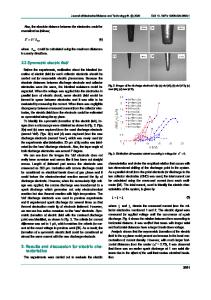Doping of Polyaniline by Corona Discharge
- PDF / 298,507 Bytes
- 6 Pages / 414.72 x 648 pts Page_size
- 62 Downloads / 343 Views
879 Mat. Res. Soc. Symp. Proc. Vol. 488 0 1998 Materials Research Society
This work reports the use of the corona discharge as a new method to efficiently dope parent polyaniline to the conductive regime [12]. The corona technique was used to dope thin layers of PANI coated on poly (ethylene terephthalate) - PET films. The effect of experimental conditions of the corona discharge on the electrical conductivity and properties of the conducting polymer is discussed. EXPERIMENT The coating of the PET films with PANI, namely PET/PANI composite, was made by chemically synthesizing parent polyaniline having a PET film immersed into the polymerization solution. The synthesis was performed by the conventional chemical method [13] at room temperature using aniline and ammonium peroxydisulfate in a solution of HC1 1.0 molar during around 60 rmin. The PET/PANI composite was deprotonated in a 0.1 molar ammonium hydroxide solution for 24 h and then dried under vacuum, in order to obtain PANI in the undoped emeraldine base (EB) oxidation state. The UV-Vis absorption spectra from the PET/PANI composite was obtained using a Perkin-Elmer model Lambda-9 Spectrophotometer. The corona discharge was generated using a corona triode system consisting of a metallic point, a stainless steel grid and a sample holder, as described elsewhere [7,12]. Corona treatments were performed in air at room temperature (-25'C) and relative humidity of about 60%. The electrical conductivity of the PANI coating was measured with the four-point probe technique. RESULTS The UV-Vis electronic absorption spectra of polyaniline is a measure of the doping state of the polymer, since it is related to the electron transition energy within the polymeric structure. In reference to Fig. 1, for corona untreated PET/PANI composite with the PANI in the undoped EB state, one main peak can be observed in the UV-Vis spectrum at around 600 rim, assigned to an excitonic transition. As such PET/PANI is exposed to a positive corona discharge the maximum wavelength (A,,,) of such peak is increased due to a decrease in the energy associated to the electronic transition and a shoulder appears at around 400nm. Such behavior is characteristic of an doping effect of the polymer, similarly to what occurs for the PANI doped by other methods, as described in the literature [1,4,13]. 1.25 2.0
Figure I - UV-Vis spectra for PANI coated onto PET films
.0
1.002
5 "0.
0o.75-
C
treated with positive corona during
/different
o 0.50 0.25
25
t'. 400
660
8a0
1600
Wavelength (nm)
880
0.to
periods of time, tt. The corona current was 15 IjA. The "treatment time is indicated for each curve and t, = 0 corresponds the PA.NI-EB.
Figure 2 shows the dependence of ý,m, corresponding to the 600 nm peak of undoped PANI, on the corona discharge treatment. It is shown that for PET/PANI composite films treated with positive and negative corona polarities, the doping degree of the polymer increases (Xmax increases) with the increase of the treatment time, reaching c.a. 850 nm (1.46 eV) for
Data Loading...









